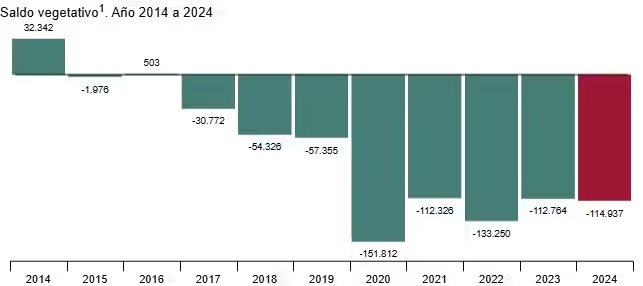Spain Sees First Increase in Birth Rate After a Decade
After ten years of continuous decline, Spain saw a slight increase in births in 2024. According to provisional data from the National Institute of Statistics (INE), 322,034 babies were born, 1,378 more than in 2023, marking a 0.43% rise. While the increase is minimal, it signals the end of a decade-long downward trend in birth rates.
Birth Rates Remain Historically Low
Despite this slight improvement, Spain’s birth rate remains at historically low levels. Compared to 2014, nearly 100,000 fewer babies were born in 2024, a decline of 24.7%. This drop aligns with a broader European trend, where many countries are experiencing lower birth rates.

Image: ine.es
Changing Motherhood Trends
One key trend in Spain is the increasing age of mothers. More women are having children later in life, with the highest birth rates now among those aged 30 to 39. The number of babies born to mothers over 40 has also risen significantly, growing from 7.2% of births in 2014 to 10.4% in 2024. This shift reflects a pattern of delayed motherhood, often influenced by financial and social factors.
Regional Differences in Birth Rates
The increase in births was not evenly distributed across Spain. Cantabria recorded the highest rise in birth rates, with a 13.31% increase in births. Other regions, such as the Balearic Islands, Castilla y León, and Madrid, also saw moderate growth. In contrast, Galicia and the Basque Country experienced declines in their birth rates.
Population Decline Continues
Despite the rise in births, Spain’s overall population continues to shrink due to a high number of deaths. In 2024, there were 439,146 deaths, a 0.7% increase from the previous year. This resulted in a negative population growth of 114,937 people, marking the eighth consecutive year of decline.

Image: ine.es
Factors Behind Spain’s Low Birth Rate
Spain’s declining birth rate is influenced by a mix of economic, social, and environmental factors. High living costs, job insecurity, and difficulties in finding affordable housing make it harder for many people to start a family. Economic uncertainty often leads couples to postpone having children or decide against it altogether.
Beyond financial concerns, social changes have also reshaped family planning. Many women are choosing to prioritize their careers, education, and personal aspirations, feeling less pressure to have children at a young age. With evolving gender roles and greater professional opportunities, parenthood is often delayed or reconsidered altogether.
Environmental factors are another growing concern. Studies have linked pollution, particularly exposure to microplastics and endocrine-disrupting chemicals, to declining fertility rates in both men and women. These pollutants, found in everything from food packaging to water sources, can interfere with hormone levels and reproductive health, making conception more difficult.
With all these factors combined, Spain’s birth rate remains at historic lows, raising concerns about the long-term demographic balance of the country.
The Future of Spain’s Population
While the slight increase in births in 2024 offers a glimmer of hope, experts warn that Spain’s low birth rate could have long-term consequences. Without policies to support young families and encourage higher birth rates, the country may continue facing challenges related to an aging population and workforce shortages.
What Can Be Done About Spain’s Declining Birth Rate?
With birth rates at historic lows, the question remains, what can be done? Some countries have introduced policies to encourage parenthood, such as financial incentives, extended parental leave, and improved childcare support. Would similar measures work in Spain, or are deeper societal changes needed?
If the trend continues, what kind of future are we heading toward? A shrinking younger population could mean labor shortages, economic slowdowns, and increasing pressure on social services as the elderly outnumber the working-age population. Could advances in technology or shifts in migration patterns balance this decline, or is Spain on course for a demographic shift that will reshape society as we know it?
What do you think? Are there solutions Spain should explore, or is this part of an inevitable global trend? Let us know what you think in the comments…
Share this content:




3 comments